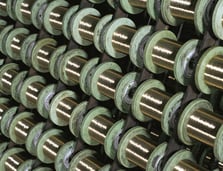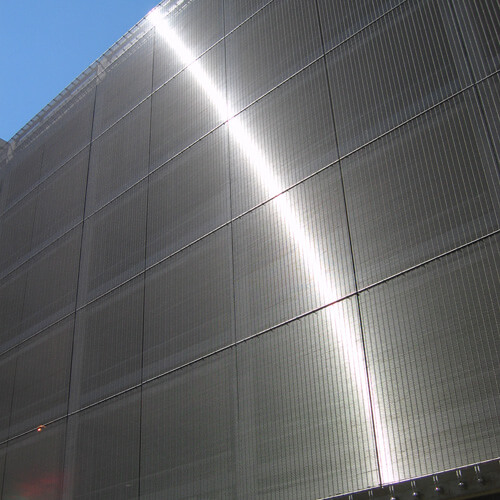Why Architectural Mesh Is Predominantly Stainless Steel
Architectural designers are constantly seeking to use the best materials in order to turn their vision into reality. In most cases, stainless steel architectural mesh offers the look, durability, and versatility to do just that.
That said, why is architectural mesh predominantly available in stainless steel when there are dozens of other alloys out there?
Having worked in the world of architectural design for over 20 years, W.S. Tyler’s team of architectural experts strives to help architects properly incorporate architectural mesh into their architectural design process.
This article will take a deep dive into why architectural mesh is typically only available in stainless steel, establishing the benefits of using stainless steel architectural mesh, the disadvantages of using architectural mesh, as well as the reasons why you may want to avoid the use of other alloys when planning your next architectural design.
Understanding Stainless Steel Alloy
 Over the years, stainless steel has become regarded as one of the most versatile materials in the world. In fact, its properties and manufacturing processes have been experimentally determined for centuries.
Over the years, stainless steel has become regarded as one of the most versatile materials in the world. In fact, its properties and manufacturing processes have been experimentally determined for centuries.
Generally, there are all types of steel that are usually classified by the quality of their alloy whether its a low alloy steel or high alloy steel. All steel classifications critically depend on the percentage of carbon that they contain.
With that, stainless steel must fall within a certain range of carbon composition percentages in order to be classified as stainless. In addition to meeting the required carbon composition percentage, steel must also contain chromium to be considered a true stainless steel alloy.
As chromium is not typically found in steel, it is added to molten steel in order to bond it on a molecular level.
Durable and Beautifying Solution
When analyzing the benefits associated with the use of stainless steel wire mesh, we must first look at the alloy that is used. Architectural mesh, especially that used for exterior applications, is constructed out of Type 316 stainless steel alloy.
316 stainless steel is the basic 18-8 alloy that is stabilized by Molybdenum, making it resistant to corrosion. This means that the mesh won’t rust or be compromised in any way when subjected to everyday weathering.
With a price range of $15-$35 per square foot, one of the biggest advantages of using stainless steel is that it tends to be more cost-effective than other materials. When comparing strength to density aluminum, for example, will generally always appear to be the better option.
That said, when comparing strength to density over price, stainless steel begins to provide more value.
Stainless steel wire mesh also produces a bright, awe-inspiring aesthetic that is one of a kind. This is ideal for designers who want to accomplish a design that makes the structure stick out among its surrounding environment.
That said, if dirt and other sediments build up on the facade and cause it to lose some of its luster, stainless steel wire mesh is easily washed with rainfall.
What are the Drawbacks of Using Stainless Steel Wire Mesh?
From a designer’s perspective, the biggest drawback of architectural mesh being only available in stainless steel is that you are limited to one material. To put this into perspective sometimes projects specify the use of other materials, such as galvanized steel.
Something else designers should take into consideration is the weight of stainless steel. There are several other materials, such as aluminum, that are much lighter than stainless steel.
While this is not common in the world of architectural mesh, this can be troublesome for projects that specifically call for a material that weighs less than a typical stainless steel structure.
There are also unique situations, such as an interior pool application, in which chemicals, like the bromine and chlorine used to treat pools, can compromise the integrity of the mesh. This is also applicable to exterior applications, as a wire mesh facade placed next to an ocean could rust as it reacts to airborne sea salt.
Now, stronger stainless steel alloys can be used to eliminate these concerns; however, when restricted to only stainless steel these issues must not be overlooked.
Why Not Use A Different Alloy?
 When looking at using a different alloy you must look at why you want or need to use that material. For example, let’s say you want to use bronze, specifically for its metallic brown color, on an exterior facade.
When looking at using a different alloy you must look at why you want or need to use that material. For example, let’s say you want to use bronze, specifically for its metallic brown color, on an exterior facade.
You would need to take the fact that bronze often oxidizes, rusts, and becomes discolored when exposed to the chemicals carried over by rain. If you want that bronze color with the durability of stainless steel, the mesh can always be painted to mimic the visual qualities of bronze.
So, how does stainless steel mesh stand up against an aluminum perforated panel?
Well, this comparison comes down to durability. Aluminum is prone to becoming scratched when harder materials come into contact with it. This can lead to galvanic corrosion.
This doesn’t exist with stainless steel, as there are no quality differentials in material from the outer layer to the inner layer.
From a manufacturing aspect, there is a general efficiency that is achieved in an operation when focusing on a single material. As dedicated looms are used to weave architectural mesh, the chances of small particles from other materials potentially compromising the surface of the mesh are minimized.
Make The Most Out Of Your Next Design
Architectural mesh is constructed from type 316 stainless steel that consists of 65-70% post consumer recycled content and can be used in an array of interior and exterior applications. As a result, it is extremely resistant to the daily weathering that it will be subjected to.
That said, designers seeking to use architectural mesh are restricted to stainless steel. This can be problematic in the case that your project calls for another alloy or material.
If your project does not specify a particular alloy and you consider another material other than stainless steel, there are several factors that need to be taken into consideration. Alloys such as bronze often oxidize, rust, and become discolored whereas aluminum is easily scratched, which eventually leads to corrosion.
With over 20 years of experience helping architectural designers implement architectural mesh, you can rest assured we are here to ensure you use the best material to create projects that will stand out for years to come.
Refer to our Architectural Wire Mesh product guide, to learn more about the possibilities of architectural mesh and make the most out of your next project.
About Ronnie Brown
Ronnie is the Content Writer for W.S. Tyler and has four years of experience as a professional writer. He strives to expand his knowledge on all things particle analysis and woven wire mesh to leverage his exceptional writing and graphic design skills, creating a one-of-a-kind experience for customers.




